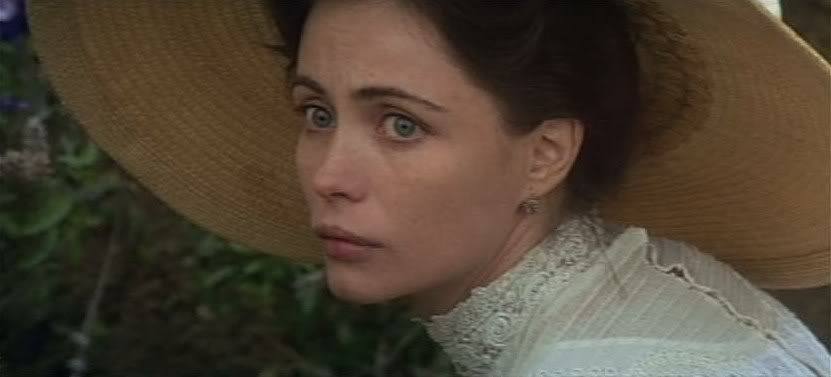
Olivier Assayas is a director with a real sense for how the massed forces — social, religious, political, economic — surrounding an individual can direct and shape that person's life. It's thus not surprising that Les destinées, a period piece that spans several decades from the early 1900s to the years between the World Wars, traces the impact of worldwide seismic shifts in culture and economics in the context of a single family and a single romance. This three-hour historical epic is thus both a departure for Assayas, who is otherwise a thoroughly modern filmmaker and thinker, and a natural fit for his detail-oriented sensibility. The film concerns the wealthy Barnery family, industrialists who run a prosperous porcelain factory that caters to wealthy tastes with extravagant, handcrafted, exquisitely designed china. This factory serves as a barometer for transformations in the world, tracing the progress towards a global economy where specialists like the Barnerys are eclipsed by more modern factories churning out mass-produced products. In the factory, tensions develop between the workers, living in poverty, and their wealthy bosses, who live lives of luxury and ease, totally isolated from the filthy conditions and meager earnings of the working class, whose troubles barely touch the Barnerys and thus barely touch the film. Assayas carefully recreates this world of luxury, allowing hints of outside struggle and outside misery to touch upon these upper-class lives in only the most incidental ways. These people are aware of poverty and aware of real suffering, but they speak of it only very rarely, and it almost never enters the film directly, only by word of mouth, as an abstract concept.
What's interesting about the film, though, is that Assayas does not demonize these prosperous industrialists. Assayas is an assiduously fair filmmaker, and he recognizes that context and culture dictate the choices available to an individual, that all of us are limited in how far we can see outside of our own circumstances. This is the case for the minister Jean Barnery (Charles Berling), who is unhappily married to the severe, intractable Nathalie (Isabelle Huppert), whose idea of marital fidelity and devotion makes marriage into a miserable bond of responsibility and obligation, with little room for love or joy. Barnery responds in kind with jealousy and moralistic preaching, until his growing affection for the young Pauline (Emmanuelle Béart), the niece of his friend Pommerel (Olivier Perrier) precipitates a decision. He divorces Nathalie, resigns from the clergy, and eventually retreats into exile in Switzerland to marry Pauline. This too is an opportunity for Assayas to probe the changing world of the turn of the century, as the stoic, religious traditionalism of the past begins to crack apart in the face of modern values and modern ideas. Late in the film, several representatives of the old school lament Jean's indecisiveness in life, his failure to maintain the façade of respectability and devotion that had been expected of him. A woman says, and her husband sagely agrees, that marriage is meant to be difficult, perhaps even unhappy, and that dissatisfaction is no reason for a divorce. What Jean and Pauline represent, in their youthful love, is the rejection of the old morality, embracing the idea that happiness and pleasure are more important than appearances or tradition.
If Jean sometimes feels twinges of guilt at his choices, Pauline, a thoroughly modern woman of the kind Assayas so obviously admires, is not so encumbered. She is blithely un-religious, unconcerned with what people think of her. She follows her emotions and her ideals, doing what she wants. She enters the film as a mystery, and at her first onscreen encounters with Jean, she seems already to have a rich history with him: the film wisely never clarifies if this is the case, or if their immediate familiarity with one another is simply a result of natural chemistry and attraction. Assayas loves this mystery, and loves actresses who can convey it: Béart, like Maggie Cheung in Irma Vep, is an enigma, a woman with rich depths of feeling behind her sweetly shy smile and big, vulnerable eyes. Assayas, one senses, never quite figures her out, and if the film has a fault it's that Pauline's enduring love for Jean, through everything, is mysterious in less satisfying ways as well. The film is weakest, in general, when it's ruminating on platitudes about love, which is spoken of in abstract terms by the overly analytical Jean and the romantic Pauline alike.
Their love for one another — and the film's broader points about finding pleasure in the muddle of life — is communicated more powerfully in Assayas' sensual, lush imagery. The couple's idyll in the Swiss mountains is captured in a lovely collage of brief scenes and sensual moments: swimming in the lake, walking through the forests, running and playing in the nude like children, enjoying the splendor of nature and the pleasure of one another's company. Another moment, later in the film and later in the characters' lives, is even more mysterious in its sensual beauty, suggesting that the moments that mean the most to us, the moments that linger in the memory in the midst of a cluttered and busy life, are sometimes the ones that seem the most prosaic and simple. It's a day when Jean, who has become embroiled in his family porcelain business and consumed by work, unexpectedly comes home from work early and sits in the garden, reading a novel and watching his wife as she picks cherries from a nearby tree. Assayas films Pauline through a screen of out-of-focus branches, as she turns her head and smiles with surprise at seeing her husband home. It's such a simple scene, but Assayas treats it poetically, respecting its emotional impact on the two aging lovers. Still later, Jean remembers this day nostalgically, remembers the voyeuristic pleasure of watching his wife without her knowing, similar to the way that she had once watched him through windows at a ball at the very beginning of the film.

Although the love story between Jean and Pauline — sometimes joyous, sometimes heartbreaking, sometimes quietly bittersweet as the couple ages — remains at the center of the film for the bulk of its length, Assayas touches on many other characters and stories along the way, in the process suggesting the sweep of the grand transformations that shook the early 20th Century. The Barnery family's struggles with its constantly striking workers reflect the battles between workers and bosses that began to tear apart the old ways of doing business around this time. Socialist idealism suggests that the Barnerys, catering only to the richest of the upper classes, are obsolete, but ironically so does the advance of global capitalism. The globalizing world, with the competition for massive foreign markets and speedy ways of mass-producing tremendous amounts of foreign goods, ushers in the collapse of the elitist business model of the Barnerys, built on old ideas about privilege and status as inalienable and unchanging constants. As Pauline tells Jean at one point, after his divorce, he may have lost his fortune, but he is still rich, because he still has his family name and the social status that goes with it. Indeed, he is able to continue living as though he was rich: even with no money, his world is still completely separate from the extreme poverty of his family's factory employees.
Modernity doesn't eliminate this condition, but it does shake things up. Aline, Jean's daughter with Nathalie, grows up under Nathalie's depressive, self-centered oversight, and when she appears as a young woman (played by Mia Hansen-Løve) she's wild and unfettered. She goes out to clubs to drink and be with men, not because it's fun but because it's something to do, some freedom from the oppressive home of her mother. Assayas touches on Aline's story only briefly, but it's poignant nonetheless. She meets and, in a scene that pays visual homage to Ingmar Bergman's Persona, seemingly falls in love with another young woman who's had a hard life, her old school friend Dominique (Sophie Aubry). Assays picks up Aline's story again years later, after more tragedy and more rebirth. The way the minor characters skip in and out of the film, eliding long periods that seem rich with incident and change, reflects the way life itself seems to skip by in cycles of despair and joy, incident and stasis, mistakes and recoveries. The film attempts to capture the pace and the breadth of life, the way years seem to fly by, dramas playing out before the status quo resumes, and all the love, joy, sadness, loss, nostalgia, work, war, and change that fills a life.
In this respect, Bergman seems like a reference point for the opening act of the film as well, particularly the raucous family drama of Fanny and Alexander. Like that film, Assayas' epic early on concerns itself with a bright, vibrant society party. Assayas' lively camera twirls around waltzing dancers, capturing the spinning motion, like human tops, and the shushing rustle of long dresses as they sweep across the dance floor. The partygoers all join hands and form a chain running through the house and around the grounds, just as the family had done in Bergman's film, and just as in Bergman's film, strict religious morality and asceticism serves as a contrast to all this joie de vivre. In this case, though, it's the minister who winds up fleeing the Protestant inflexibility of his moralistic wife, choosing a life in which pleasure and joy, however fleeting they wind up being, matter more than empty principles and joyless responsibility. If Jean, in the end, winds up chained instead to a very different form of responsibility — the capitalist's slavery to profits over morality — he stills lives a full and varied life. Ultimately, he wonders how, in spite of everything, there still seems to be some hope at the core of life; this line, with its implication that happiness lies in a searching, open-minded sensibility, seems like a key to Assayas' rich, ambitious and complex social drama.

2 comments:
Lovely, as usual.
Cheers!
Thanks, JAFB!
Post a Comment